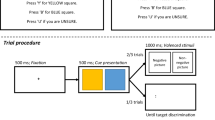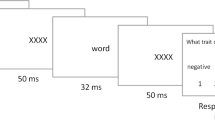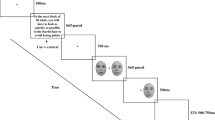Abstract
The current study investigated the relationship between processing biases towards affectively negative words and a film-based mood manipulation procedure. Subjects either watched a film about nuclear war or sat alone for ten minutes and then colournamed sets of negative, positive and neutral words. Testing occurred after one of three possible time intervals. Impaired colour-naming of negative words was found both immediately and five minutes after watching the film. There was no consistent pattern of colour-naming impairments for the positive words. It was found that, when baseline Stroop performance was taken into account, and the semantic priming effect caused by stimulus homogeneity was controlled for, the resulting impairment in the colournaming of negative words was accounted for by state anxiety levels alone, and not the previously found interaction of state and trait anxiety.
Similar content being viewed by others
References
Eysenck, M.W. (1991). Cognitive factors in clinical psychology: Potential relevance to therapy. In P.R. Martin (Ed.),Handbook of Behaviour Therapy and Psychological Science: An Integrative Approach. New York: Pergamon.
Francis, W.N., & Kucera, H. (1982).Frequency analysis of English usage. Boston MA: Houghton & Mifflin.
Isen, A.M., & Gorgoglione, J.M. (1983). Some specific effects of four affect induction procedures.Personality and Social Psychology Bulletin, 9, 136–143.
Green, M.W., Rogers, P.J., & Elliman, N.A. (1995). Change in affective state assessed by impaired colournaming of threat-related words.Current Psychology: Research and Reviews, 14:3, 222–232.
MacLeod, C. (1990). Mood disorders and cognition. In M.W. Eysenck (Ed.),Cognitive Psychology: An International Review. Chichester: Wiley.
MacLeod, C., Mathews, A., & Tata, P. (1986). Attentional bias in emotional disorders.Journal of Abnormal Psychology, 95, 15–20.
Martin, M., Williams, R.M., & Clark, D.M. (1991). Does anxiety lead to the selective processing of threat-related information.Behaviour Research and Therapy, 29, 147–160.
Mathews, A., & MacLeod, C. (1985). Selective processing of threat cues in anxiety states.Behaviour Research and Therapy, 31, 563–569.
Mogg, K., Kentish, J., & Bradley, B.P. (1993). Effects of anxiety and awareness on colour-identification latencies for emotional words.Behaviour Research and Therapy, 31, 559–567.
Mogg, K., & Marden, B. (1990). Processing of emotional information in anxious subjects.British Journal of Clinical Psychology, 29, 227–229.
Mogg, K., Mathews, A., Bird, C., & MacGregor-Morris, R. (1990). Effects of stress and anxiety on the processing of threat stimuli.Journal of Personality and Social Psychology, 59, 1230–1237.
Mogg, K., Mathews, A., Eysenck, M.W., & May, J. (1991). Biased cognitive operations in anxiety: Artefact, processing priorities or attentional search.British Journal of Clinical Psychology, 29, 459–467.
Pratto, F. & John, O.P. (1991). Automatic vigilance: The attention grabbing power of negative social information.Journal of Personality and Social Psychology, 61, 380–391.
Ray, C. (1979). Examination stress and performance on a colour-word interference test.Perceptual and Motor Skills, 49, 400–402.
Richards, A., & Millwood, B. (1989). Colour-identification of differentially valenced words in anxiety.Cognition and Emotion, 3, 171–176.
Richards, A., French, C.C., Johnson, W., Naparstek, J., & Williams, J. (1992). Effects of mood manipulation and anxiety on performance of an emotional Stroop task.British Journal of Psychology, 83, 479–491.
Spielberger, C.D., Gorsuch, R.L., Luschene, R., Vagg, P.R., & Jacobs, G.A. (1983).Manual for the State-Trait Anxiety Inventory. Palo Alto, CA: Consulting Psychologists Press.
Stroop, J.R. (1935). Studies of interference in serial verbal interactions.Journal of Experimental Psychology, 18, 643–662.
Author information
Authors and Affiliations
Rights and permissions
About this article
Cite this article
Green, M.W., Rogers, P.J. & Hedderley, D. The time course of mood-induced decrements in colour-naming of threat-related words. Current Psychology 14, 350–358 (1996). https://doi.org/10.1007/BF02686923
Accepted:
Issue Date:
DOI: https://doi.org/10.1007/BF02686923




